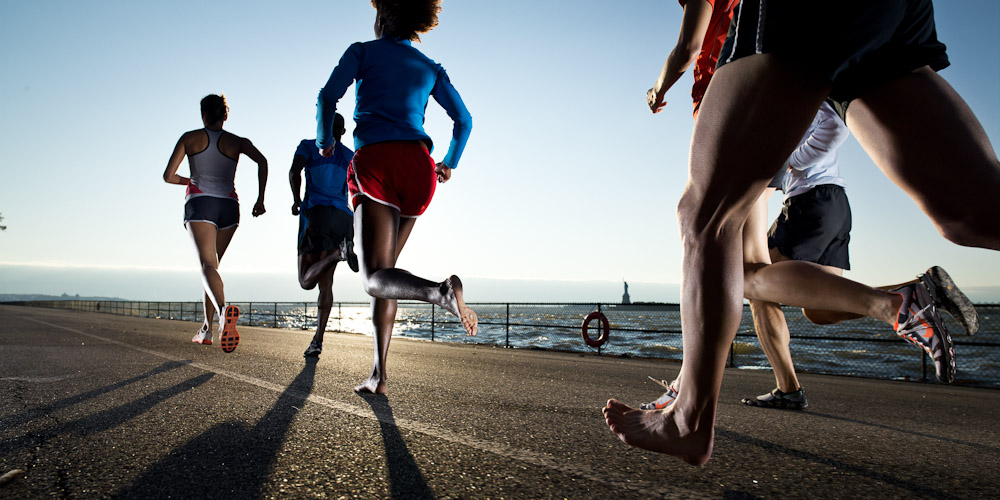Undergraduate perspective on Sport & Exercise Medicine
By Rory Heath, Bethany Koh, Vera Wong and Anant Shah.
Two expert speakers were recently in session at the Barefoot Running Clinic, hosted by the London Sports and Exercise Medicine Society (LSEMS):
- Mr Ioan Tudur-Jones, consultant foot and ankle surgeon at the Fortius Clinic, and;
- Mr Ben Le Vesconte, a running technique specialist.
 ‘Barefoot’, or ‘minimalist’ running describes a step away from heavily padded conventional sports shoes, to wearing either a minimally supportive shoe, or no shoe at all!
‘Barefoot’, or ‘minimalist’ running describes a step away from heavily padded conventional sports shoes, to wearing either a minimally supportive shoe, or no shoe at all!
It was a true multidisciplinary meeting, with medical students, doctors, physiotherapists and podiatrists from all universities London-wide. The fantastic talks were followed by diverse and lively discussion. Here are the learning points that we took away!
- Humans evolved as “hunter-gatherers” who spent a lot of time on their feet, moving about. Mr Ben Le Vesconte suggested that standing, walking, running, and squatting are natural movement patterns of Homo Sapiens. Today’s society places us in unnatural habitats that encourage sedentary lifestyles, far removing us from these natural movements. We were not made to sit around on our bums all day!
GET ACTIVE!
- We commonly promote the myriad health benefits of physical activity, however, it is important to consider that exercise may incur injury risk. Running is popular, but is associated with high rates of lower limb injury – 70% of runners are injured each year1!
- One study of 54 competitive cross country runners at Harvard who ran a weekly average of 40-15 miles reported that runners who “heel strike” (land on their heels) were shown to have over double the amount of lower limb mild-moderate repetitive stress injuries vs runners who landed on their forefoot2.
- Despite attempts by the running shoe industry to reduce injury, rates remain high. Daroud’s paper suggests cushioned shoes alter the biomechanics in the ankle, knee and hip joints, as well as encourage a heel-strike, therefore encouraging injury2.
Is it technique, footwear and improper loading that contributes to our large injury burden? We should be wary of this when prescribing activity to patients.
- Leonardo da Vinci said ‘The human foot is a masterpiece of engineering and a work of art’. There are 200,000 nerve endings, and lots of muscles in the foot. Our curriculums rarely encourage us to learn the intricacies of our pedal anatomy. We think that to appreciate its complexity and function, we must look at it as a whole (as we do with any other part of the body!).
- Most people only notice the long ‘extrinsic’ muscles because they provide power, propelling the foot forwards. Although it is easy to overlook the smaller ‘intrinsic’ muscles, they control the fine motor movements of the toes and joints. A small study of 20 experienced runners suggested that runners with plantar fasciitis have significantly smaller muscles in the rear of their feet in comparison to runners without the same pathology3.
Both speakers suggested actively training the intrinsic muscles for optimum function and performance.
- Some research has shown that barefoot running may actually increase the incidence of injury4. Our event speculated this is due to poor transition from a rear-foot to fore-foot strike, due to inadequate education, improper technique or excessive and rapid loading of deconditioned tissues.
Coaching and follow up is key to ensuring a smooth transition.
Although both talks supported barefoot running, the discussion included varied opinions from both sides of the argument. Our main take-away is that the heart of barefoot running respects the ‘intended’ biomechanics and anatomy of the foot. It can offer benefits to individuals who are appropriately conditioned or can safely transition to a new running technique. It might not be for everyone; our sedentary modern world has shaped our bodies, making a switch to barefoot running difficult for some, and possibly dangerous if done rapidly. It is, however, an option to consider for those wishing to explore how to return their feet to their natural form, and run the way we were meant to run.
To hear more on this topic from Mr Ioan Tudur-Jones and learn more about the Fortius Clinic have a listen to this fantastic podcast conducted by Anant Shah (LSEMS Secretary)!
************************
Written by Rory Heath (@roryjheath), Bethany Koh (@bethanykoh) and Vera Wong. Podcast recorded by Anant Shah and Mr Ioan Tudur Jones, at the Fortius Clinic, London.
Find the London Sports and Exercise Medicine on Facebook and Twitter!
Manroy Sahni (@manroysahni) coordinates the BJSM Undergraduate Perspective blog series. He also serves as Education Officer for the Undergraduate Sports and Exercise Medicine Society (USEMS) committee and Co-President of Birmingham University Sports and Exercise Medicine Society (BUSEMS).
References
- Van Gent RN, Siem D, Van Middelkoop M, Van Os AG, Bierma-Zeinstra SMA, Koes BW. Incidence and determinants of lower extremity running injuries in long distance runners: a systematic review. Br J Sport Med. 2007;41:469-480. doi:10.1136/bjsm.2006.033548.
- DAOUD AI, GEISSLER GJ, WANG F, SARETSKY J, DAOUD YA, LIEBERMAN DE. Foot Strike and Injury Rates in Endurance Runners. Med Sci Sport Exerc. 2012;44(7):1325-1334. doi:10.1249/MSS.0b013e3182465115.
- Cheung RTH, Sze LKY, Mok NW, Ng GYF. Intrinsic foot muscle volume in experienced runners with and without chronic plantar fasciitis. J Sci Med Sport. 2016;19(9):713-715. doi:10.1016/j.jsams.2015.11.004.
- Ryan M, Elashi M, Newsham-West R, Taunton J. Examining injury risk and pain perception in runners using minimalist footwear. Br J Sports Med. 2014;48(16):1257-1262. doi:10.1136/bjsports-2012-092061.